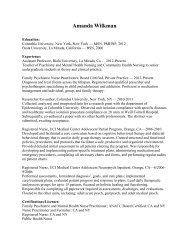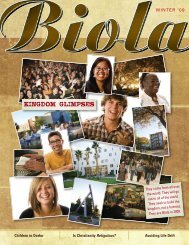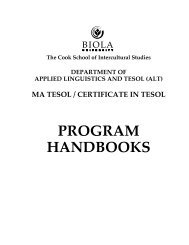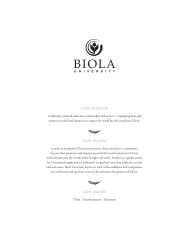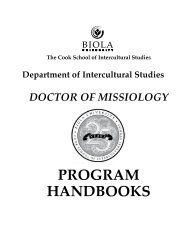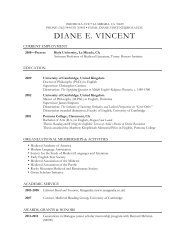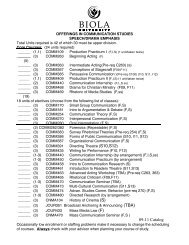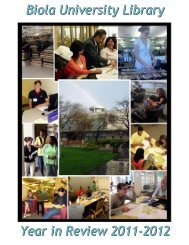New President, New Century New President, New ... - Biola University
New President, New Century New President, New ... - Biola University
New President, New Century New President, New ... - Biola University
Create successful ePaper yourself
Turn your PDF publications into a flip-book with our unique Google optimized e-Paper software.
Saving ‘SimMan’<br />
08<br />
RED REPORT<br />
Nursing students Katie Potter (background) and Emily Svelmoe (foreground) work on SimMan, who is controlled by professor Annette Browning (below).<br />
The patient lies propped up on his back,<br />
IVs inserted in veins in his arm. His vital<br />
signs are displayed on a monitor nearby.<br />
“I can’t breathe and my chest hurts,”<br />
he says. “Help.”<br />
From a computer a few feet away, <strong>Biola</strong><br />
nursing professor Annette Browning holds the<br />
patient’s fate in her hands. Literally.<br />
With a few strokes on her keyboard,<br />
Browning can change the patient’s heart rate,<br />
make him wheeze, even decide what he will<br />
say next.<br />
The “patient” is a high fidelity mannequin<br />
named SimMan, an advanced patient<br />
simulator that allows students to hone their<br />
skills without fear of harming anyone. Two<br />
video cameras mounted above SimMan’s bed<br />
record the students’ responses to particular<br />
scenarios.<br />
Browning can lead the students through a<br />
critical situation by programming SimMan to<br />
have different pathologies, such as septic<br />
shock or congestive heart failure.<br />
Acquired by <strong>Biola</strong>’s nursing department<br />
in May, SimMan has pulses, lung and heart<br />
sounds, realistic anatomy – even a catheter.<br />
Students can administer medication, take<br />
blood pressure and check temperature. They<br />
can also use SimMan to practice CPR when<br />
Browning makes SimMan “code” (go into<br />
cardiac arrest).<br />
SimMan rests in the Kartsman Simulation<br />
Michael Musser<br />
Lab in Soubirou Hall. The lab looks like a<br />
hospital room in an intensive care unit.<br />
While simulation has been used for<br />
decades in the armed services and in aviation,<br />
its use in nursing education is relatively new,<br />
said Browning, who teaches critical care<br />
courses. SimMan has the potential to be used<br />
in many clinical courses, she said, and should<br />
decrease students’ level of anxiety when they<br />
care for a patient.<br />
“In the real hospital situation, when the<br />
patient goes into a critical (situation), students<br />
tend to fall back into an observation role,” she<br />
said. With the simulator, “the students can<br />
attempt to problem solve and intervene and<br />
assess and treat and critically think without<br />
harm to the patient.”<br />
Nursing students who have practiced with<br />
SimMan say it provided a unique learning<br />
experience.<br />
Shannon Lawrence, a <strong>Biola</strong> graduate now<br />
working at Loma Linda <strong>University</strong> Medical<br />
Center, said SimMan gave her a chance to<br />
practice without the pressure of doing<br />
something wrong or hurting a patient.<br />
“It gives you the opportunity to try things<br />
and be comfortable and then try it again in the<br />
workplace,” she said. — Lisa O’Neill Hill<br />
BIOLA<br />
Michael Musser



